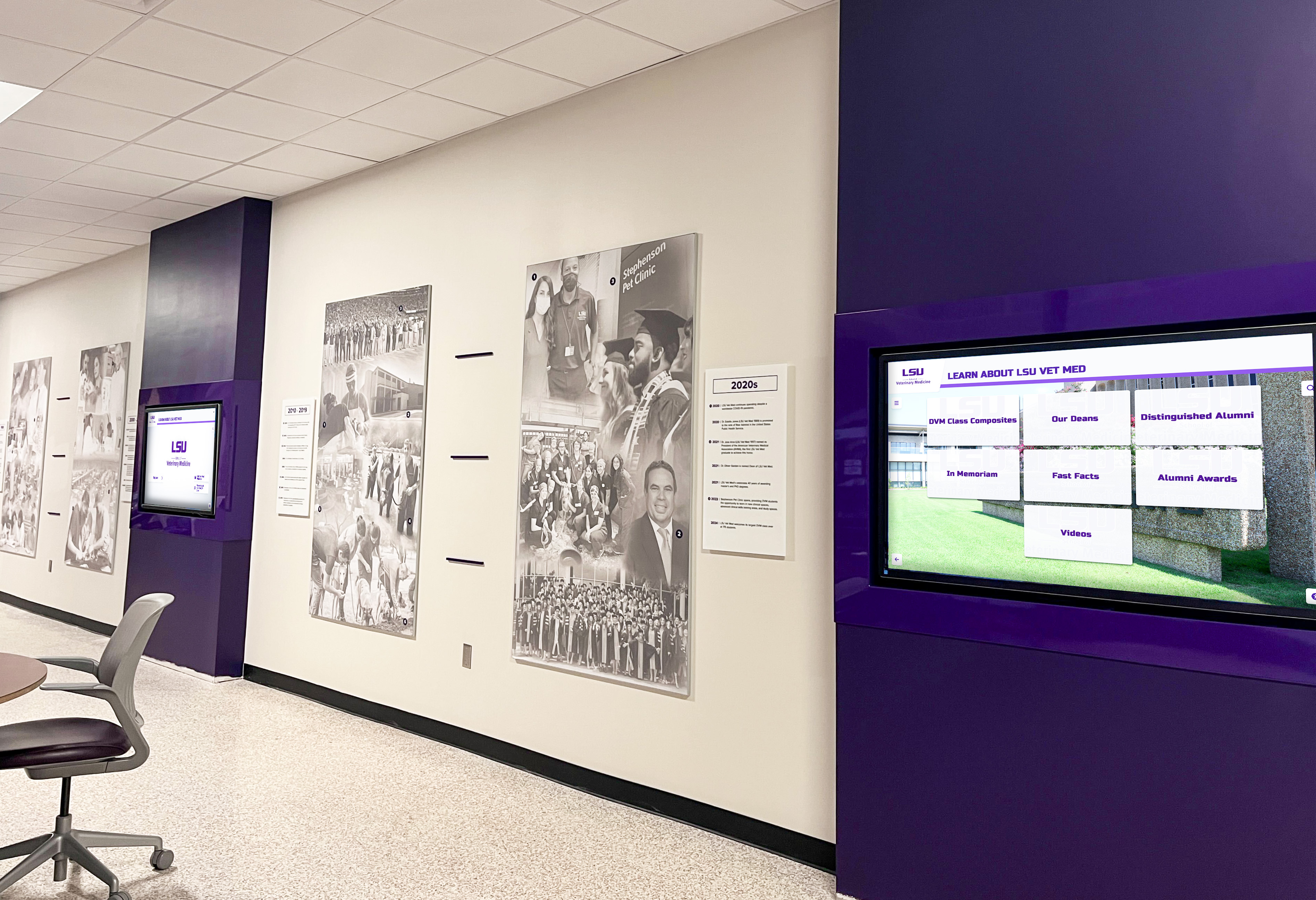The National Football League represents the pinnacle of professional football achievement, where the world’s most talented athletes compete at the highest level. Hall of fame recognition programs serve as essential institutions for preserving the sport’s history, celebrating extraordinary achievement, and inspiring future generations of players, coaches, and fans. From the prestigious Pro Football Hall of Fame in Canton, Ohio, to team-specific recognition programs across all 32 franchises, these halls of fame create lasting tributes to football excellence.
Whether you’re a sports organization planning a recognition program, a facility manager evaluating display solutions, or a football enthusiast interested in how legends are celebrated, this guide provides valuable insights into NFL hall of fame traditions and innovations.
The Pro Football Hall of Fame: Football’s Highest Honor
The Pro Football Hall of Fame stands as professional football’s most prestigious institution, recognizing individuals who have made exceptional contributions to the sport through extraordinary performance, innovation, and character.
History and Significance
Founded in 1963 in Canton, Ohio—the birthplace of professional football where the American Professional Football Association (later renamed the National Football League) was established in 1920—the Pro Football Hall of Fame serves as the sport’s official museum and recognition center. The location in Canton carries profound symbolic significance, connecting modern football to its historical roots.
The Hall of Fame opened its doors on September 7, 1963, with 17 charter members including legends like Jim Thorpe, Red Grange, Bronko Nagurski, and George Halas. In the decades since, the institution has grown to enshrine over 350 members, each representing the highest standard of football excellence.
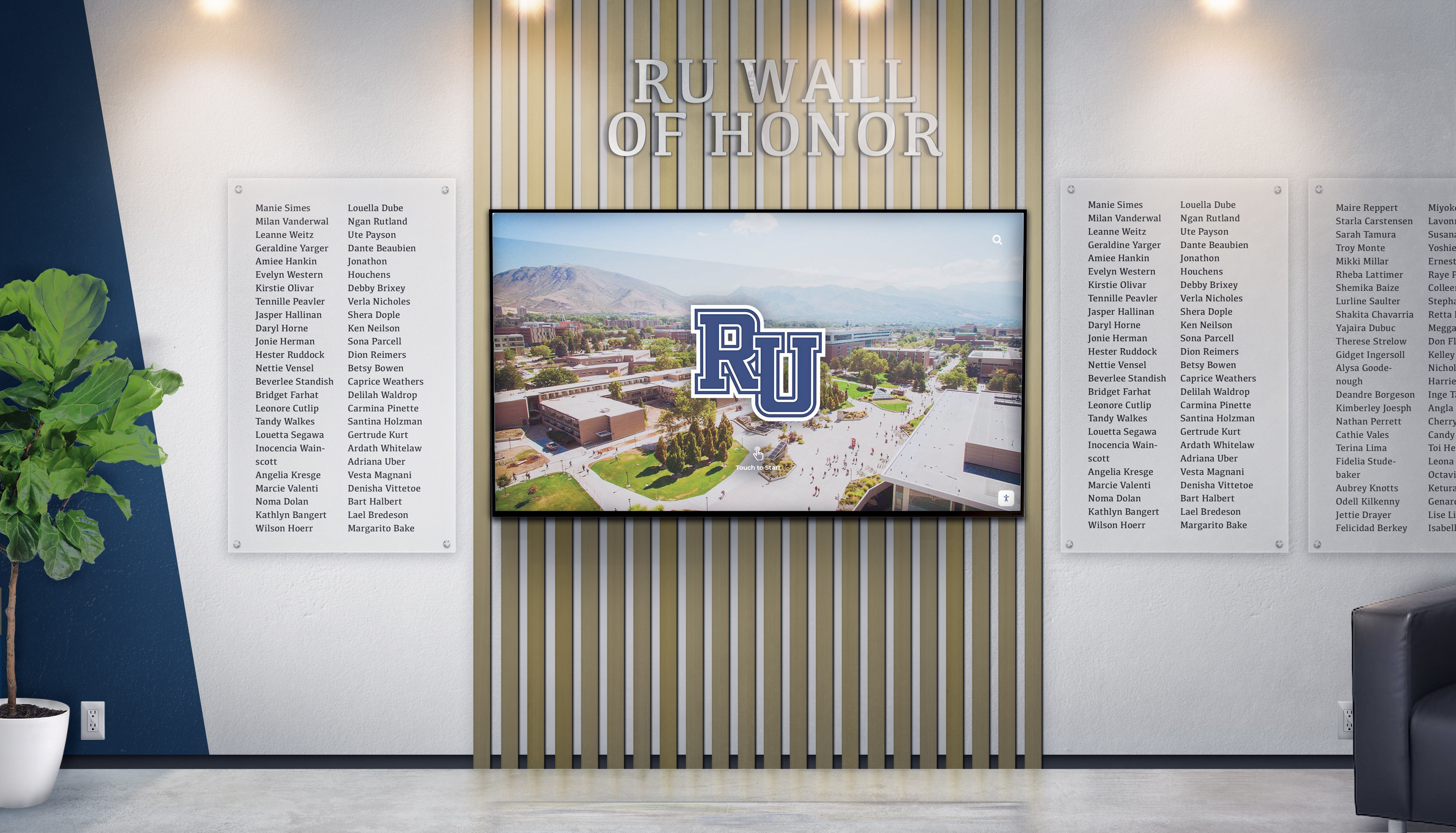
The Pro Football Hall of Fame serves multiple purposes beyond simple recognition. It preserves professional football history through extensive exhibits and archives, educates visitors about the sport’s evolution and cultural impact, inspires current and future players through examples of sustained excellence, and provides a gathering place for the football community during annual induction ceremonies.
Selection Process and Criteria
The Pro Football Hall of Fame maintains rigorous selection standards ensuring that only truly exceptional contributors receive enshrinement. The selection process involves multiple stages designed to identify candidates who demonstrated sustained excellence throughout their careers.
Modern-era player candidates become eligible five years after retirement. This waiting period allows sufficient time for achievements to be evaluated in appropriate context. The Selection Committee, comprising 50 football writers and broadcasters—one from each current NFL city plus one representative from the Pro Football Hall of Fame—evaluates candidates annually.
Selection criteria emphasize multiple dimensions of contribution and excellence. Players must have demonstrated sustained performance over multiple seasons rather than brief periods of brilliance. Postseason success and ability to perform in critical moments receive significant consideration. Leadership qualities and impact on teammates and organizations matter substantially. Character and sportsmanship both during and after playing careers influence evaluations. And contributions to the sport beyond individual statistics—such as innovation, position redefinition, or cultural impact—receive appropriate recognition.
Coaches become eligible immediately upon retirement or one year after their last season. Contributors—including team owners, general managers, and other non-player/non-coach individuals—can be considered at any time. These categories recognize that football excellence extends beyond on-field performance.

The selection process culminates annually when the committee meets before the Super Bowl to determine the newest class of enshrinees. Voting occurs in rounds, with candidates requiring 80% approval for selection. This high threshold ensures broad consensus about each inductee’s qualifications.
The Induction Ceremony
The annual Pro Football Hall of Fame Enshrinement Ceremony ranks among professional sports’ most prestigious events. Held each summer in Canton, the weekend-long celebration includes the induction ceremony itself, the Hall of Fame Game (the NFL’s annual preseason opener), autograph sessions, and various fan events.
Inductees deliver acceptance speeches that often rank among the sport’s most emotional and memorable moments. Players typically acknowledge teammates, coaches, family members, and others who contributed to their success. These speeches humanize achievements, reminding audiences that sustained excellence requires support systems and sacrifice from many people.
Team-Specific NFL Hall of Fame Programs
Beyond the national Pro Football Hall of Fame, most NFL franchises operate their own hall of fame or ring of honor programs celebrating team-specific legends and memorable achievements.
Purpose and Scope of Team Halls of Fame
Team halls of fame serve distinct purposes from the national institution. They recognize excellence within franchise contexts, honoring players, coaches, and contributors whose impact proved transformational for specific organizations even when national recognition may not have been achieved.
Many exceptional players who enjoyed outstanding careers with particular teams may not meet the exceptionally high standards for Canton enshrinement but absolutely deserve recognition within their franchise contexts. Team halls of fame provide appropriate platforms for celebrating these contributors.
These programs also preserve team-specific history and traditions that broader institutions cannot adequately capture. Memorable seasons, franchise-defining moments, beloved local figures, and cultural touchstones specific to particular fan communities all find appropriate recognition in team hall of fame programs.
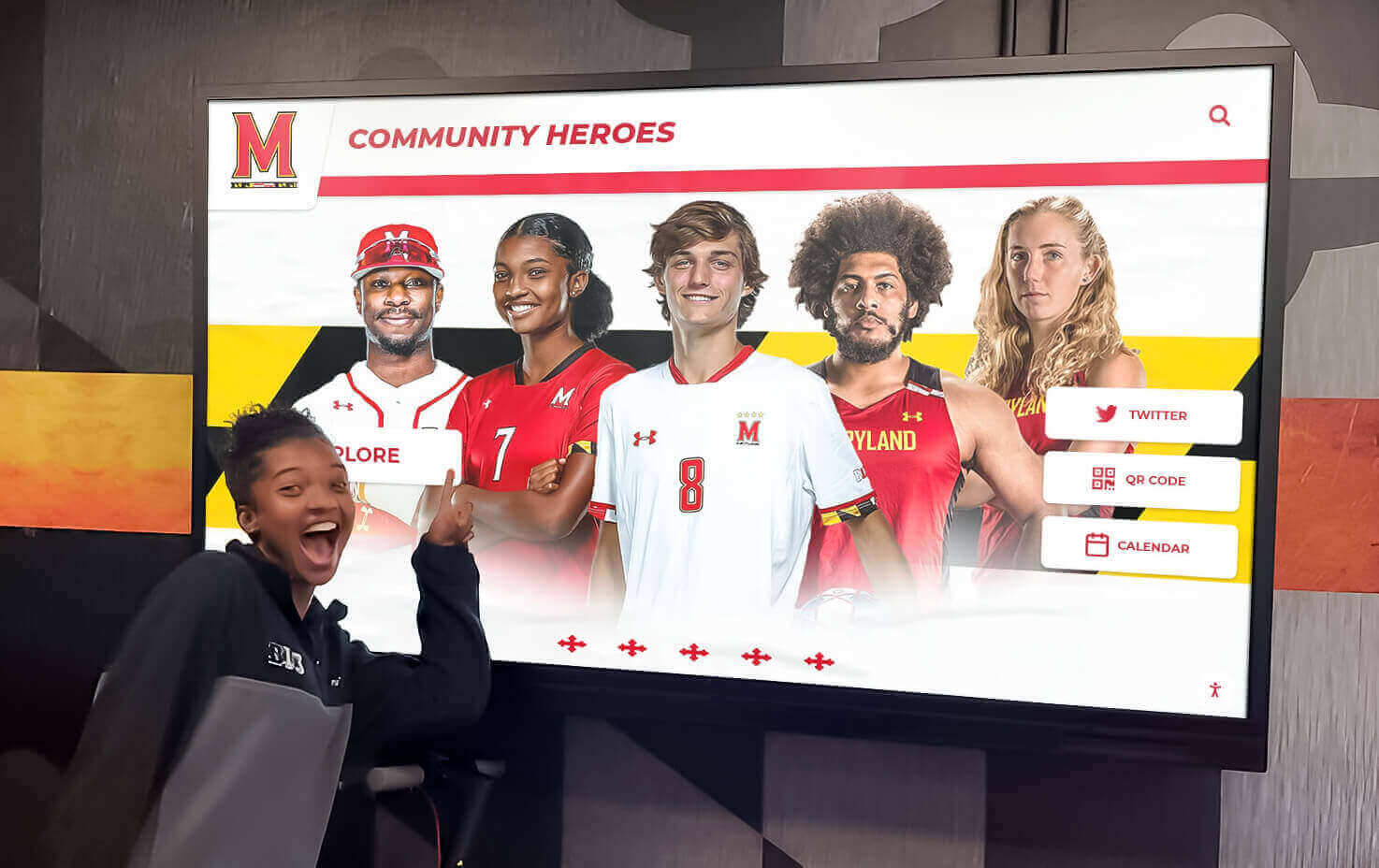
Team recognition programs strengthen franchise identity and fan engagement. They demonstrate organizational commitment to honoring those who built success, create emotional connections between current and historical teams, and provide content for game-day experiences, facility tours, and community engagement initiatives.
Common Team Recognition Formats
NFL teams employ various formats for recognizing franchise legends, each with distinct characteristics and traditions.
Ring of Honor programs represent the most common approach. These programs identify elite franchise contributors and display their names or numbers prominently in team stadiums—typically on facade sections, luxury suite areas, or dedicated recognition locations visible to all fans. The Dallas Cowboys pioneered this concept in 1975, and many teams have adopted variations since.
Formal team hall of fame programs operate similarly to the national institution but with franchise-specific scope. These programs typically feature physical displays at team facilities or stadiums, annual induction classes selected through defined processes, induction ceremonies often held during game weekends, and comprehensive biographical content about inductees.
Retired number programs represent the highest franchise honors. When teams retire jersey numbers, they permanently remove them from circulation, ensuring no future player can wear those digits. This exclusive recognition typically reserves itself for the most transformational franchise figures.
Many teams implement hybrid approaches combining multiple recognition formats. A franchise might maintain a hall of fame with broad membership while reserving number retirement for only the most exceptional contributors, creating tiered recognition that celebrates various levels of achievement.
Selection Processes for Team Programs
Team hall of fame selection processes vary across franchises but generally include several common elements. Most teams establish selection committees including former players and coaches from various eras, team executives and ownership representatives, media members who covered the franchise, and sometimes fan representation through voting or input mechanisms.
Selection criteria typically consider on-field achievement within team contexts, longevity and sustained excellence with the franchise, team success and championship contributions, statistical accomplishments and records, leadership and cultural impact, and contributions to community and charitable activities.
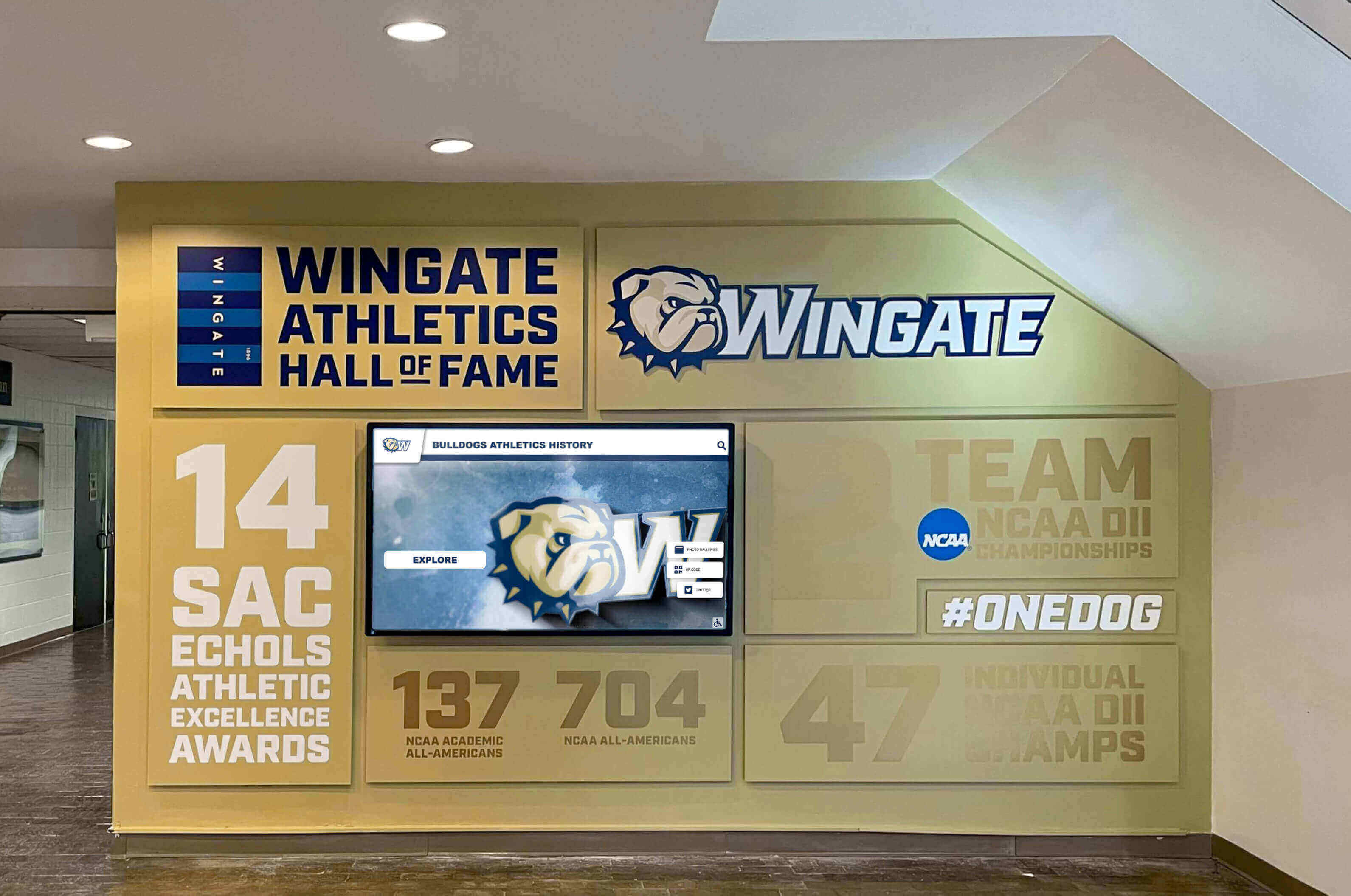
Most team programs require minimum time periods—commonly 5-10 years—between retirement and eligibility, allowing appropriate perspective on candidates’ legacies. This waiting period prevents reactionary selections based on recent memory rather than sustained historical significance.
Modern Recognition Technology for Football Programs
While the Pro Football Hall of Fame and many team facilities feature traditional physical displays, modern digital recognition technology provides innovative approaches for celebrating football excellence in various organizational contexts.
Digital Hall of Fame Applications Beyond Canton
Professional football organizations, sports facilities, youth football programs, athletic training centers, and sports museums increasingly implement digital recognition systems to celebrate football achievement at various levels.
These applications extend far beyond simply replicating Canton’s approach. Organizations leverage digital technology to create customized recognition programs appropriate to their specific contexts, audiences, and objectives. A youth football organization might create digital displays celebrating program alumni who advanced to college or professional levels. A training facility might recognize athletes who trained there and achieved success. A sports museum might create comprehensive databases documenting local football history.
Solutions like Rocket Alumni Solutions provide platforms specifically designed for sports recognition across multiple levels and contexts, enabling organizations to create professional-quality recognition programs regardless of size or budget.
Interactive Touchscreen Recognition Systems
Digital recognition displays utilize touchscreen technology to create engaging experiences where visitors actively explore player profiles, team histories, memorable games, and statistical achievements.
These systems typically feature commercial-grade touchscreen displays ranging from 55 to 75 inches, cloud-based content management systems enabling easy updates, searchable databases allowing visitors to find specific players, positions, or eras, and multimedia content including photos, videos, statistics, and narrative biographies.
The advantages over traditional physical displays prove substantial for football recognition programs. Unlimited capacity means every deserving player receives appropriate recognition without space constraints. Instant updates through software rather than physical construction allow timely additions of new honorees. Rich storytelling through video highlights, extended career narratives, and photo galleries brings achievements to life. Advanced search and filter functions help visitors navigate extensive content by position, era, team, or achievement type. And engagement analytics reveal how visitors interact with content, informing ongoing development priorities.
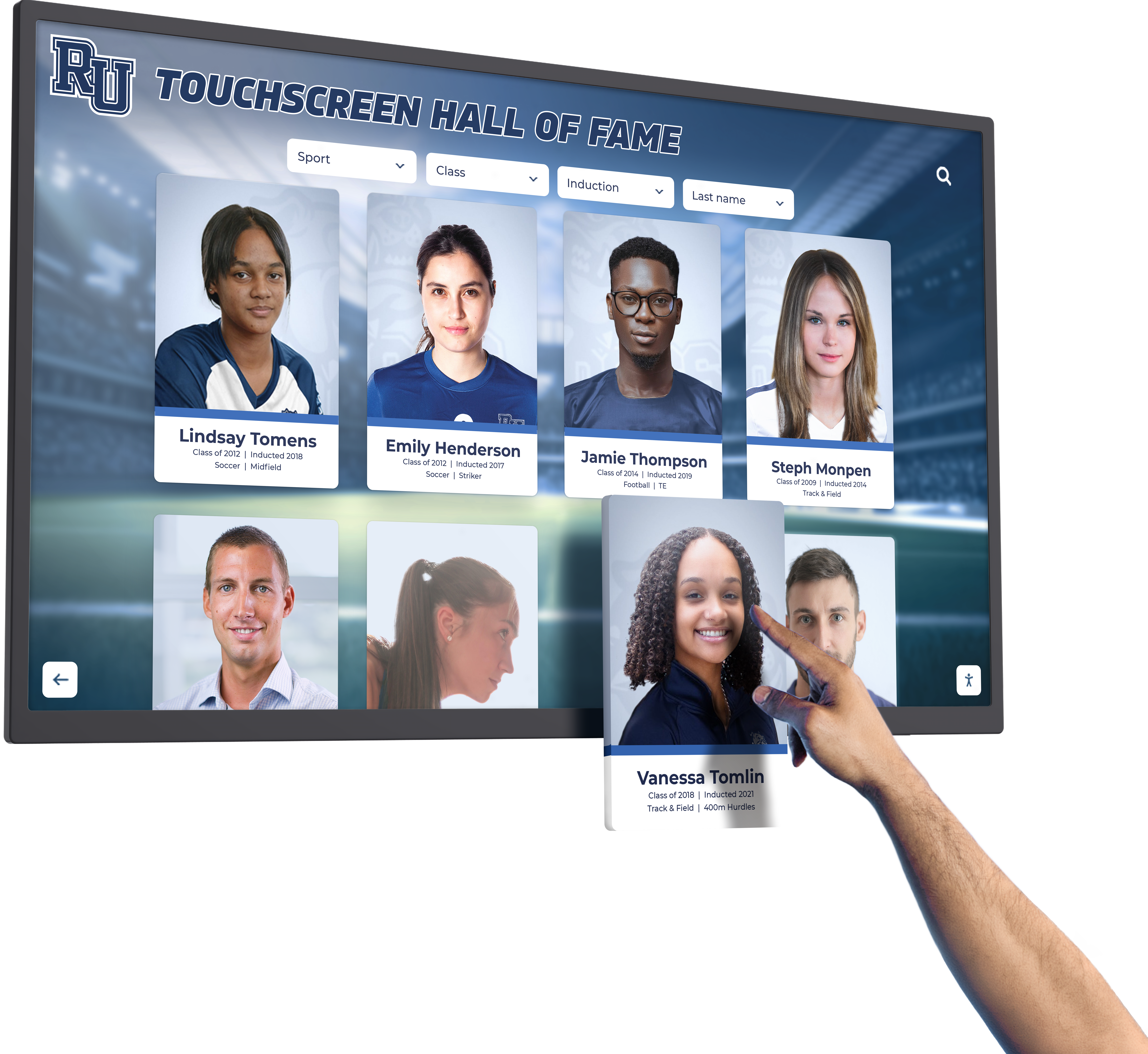
Multimedia Content Capabilities
Digital platforms excel at incorporating diverse content types that bring football achievements to life in ways traditional plaques cannot match. Game footage and highlight reels showcase athletic excellence and memorable moments. Audio interviews with players and coaches provide personal perspectives and behind-the-scenes insights. Historical photographs from multiple career stages document athletic journeys. Statistical visualizations present career achievements in engaging formats. And newspaper clippings and media coverage provide historical context about how achievements were perceived contemporaneously.
This multimedia richness creates more engaging visitor experiences than text-based displays alone. A visitor exploring a quarterback’s profile might watch touchdown passes, hear the player discuss significant games, view photographs from throughout the career, examine statistical comparisons to other franchise quarterbacks, and read contemporary media coverage—all within a single comprehensive digital profile.
Online and Mobile Access
Modern recognition programs increasingly extend beyond physical locations through online and mobile platforms. Web-based hall of fame sites allow fans anywhere to explore content, mobile applications provide convenient access during facility visits or remote exploration, social sharing capabilities amplify recognition reach across digital platforms, and integration with official team or organization websites creates cohesive digital experiences.
This digital accessibility democratizes access to recognition content. Fans who cannot visit Canton or team facilities can still explore comprehensive hall of fame information. Alumni who moved away from their hometowns can revisit recognition content celebrating their achievements. Researchers studying football history can access extensive databases documenting the sport’s evolution.
Creating Football Recognition Programs: Practical Considerations
Organizations interested in creating football recognition programs—whether team-specific halls of fame, youth program recognition systems, or facility-based displays—should consider several key factors.
Defining Program Scope and Objectives
Clear objective definition proves essential for guiding all subsequent decisions. Recognition programs might aim to honor past excellence while inspiring current participants, strengthen community and fan engagement, preserve organizational history and tradition, support facility tours and visitor experiences, or enhance fundraising and development initiatives through recognition-based giving opportunities.
Understanding primary objectives helps determine appropriate program scope, recognition criteria, display approaches, and content priorities. A youth football program aiming to inspire current players might emphasize recent alumni who advanced to college programs. A sports museum documenting local history might prioritize comprehensive coverage across many decades.

Establishing Selection Criteria
Transparent, consistent selection criteria maintain program credibility and ensure deserving candidates receive appropriate recognition. Criteria should reflect organizational values and objectives while remaining achievable within practical constraints.
Common criteria elements include performance standards appropriate to program level, sustained excellence over multiple seasons rather than brief peak performance, leadership and character considerations, contributions beyond individual statistics, and minimum time periods between retirement and eligibility ensuring appropriate historical perspective.
Document criteria clearly and communicate them transparently to all stakeholders. This transparency manages expectations and demonstrates fairness, particularly when difficult decisions must be made about borderline candidates.
Budgeting for Recognition Programs
Recognition program costs vary dramatically based on scope, display approach, and ongoing management requirements. Initial investments might include display hardware or digital systems ranging from $10,000 to $50,000+ for comprehensive installations, content development including research, writing, photography, and multimedia production, design and branding aligning displays with organizational identity, installation and integration within facilities, and launch events and communications.
Ongoing expenses include annual induction ceremonies and events, periodic content updates and additions, display maintenance and technical support, software licensing for digital systems, and marketing and communications promoting recognition programs.
Many organizations fund recognition programs through operating budgets, dedicated fundraising campaigns, corporate sponsorships, inductee contributions, and revenue from events or tours. Strategic recognition displays often support broader organizational objectives like fundraising, recruitment, or community engagement, helping justify sustained investment.
Location and Display Strategies
Recognition display location significantly impacts effectiveness and visitor engagement. Ideal locations provide high visibility to target audiences, appropriate space for comfortable viewing and interaction, symbolic significance within facilities, and integration with tours, events, or game-day experiences.

Common successful locations include facility main entrances or lobbies, hallways or concourses with natural foot traffic, dedicated hall of fame rooms or galleries when space and budget allow, and integration with other experiential elements like museums or visitor centers.
For digital displays, ensure locations provide necessary infrastructure including reliable power, network connectivity for cloud-based systems and content updates, adequate lighting control to prevent screen glare, and appropriate environmental conditions protecting equipment.
Content Development for Football Recognition
Compelling content transforms recognition programs from simple name lists into engaging experiences that educate, inspire, and connect visitors with football history.
Player Profile Structure
Comprehensive player profiles should include essential biographical and statistical information along with narrative elements that tell complete stories. Standard elements include full name and any nicknames, positions played and physical measurements, teams and years of service, career statistics and significant records, awards, honors, and recognitions, championship participation and postseason achievements, and post-football career highlights.
Beyond basics, engaging profiles incorporate narrative depth including the path to professional football, significant games or moments defining careers, relationships with teammates and coaches, obstacles overcome and challenges faced, impact on the sport beyond statistics, and personal reflections when available through interviews or archival material.

Digital platforms accommodate extensive content impossible to fit on physical plaques, enabling storytelling depth that creates meaningful connections with visitors and preserves richer historical context.
Team and Season Recognition
Beyond individual profiles, football recognition programs should celebrate memorable teams and seasons. Championship team profiles might include complete rosters with links to individual profiles where available, season records and playoff results, coaching staff and front-office leadership, game-by-game results and statistical leaders, significant games and defining moments, and historical context about the championship’s significance within franchise or league history.
This team-level content helps visitors understand how individual excellence contributed to collective success while celebrating the collaborative nature of football achievement.
Coaching and Contributor Recognition
Comprehensive football recognition extends beyond players to honor coaches, executives, and other contributors who enabled success. Coaching profiles should document career records and championships, years of service and teams led, player development and protégés who became successful, tactical innovations and strategic contributions, and character and leadership philosophy.
Contributor recognition might celebrate team owners who built successful organizations, general managers and executives who assembled championship rosters, scouts who identified exceptional talent, medical and training staff who enabled player health and performance, and media members who documented and promoted the sport.
These broader recognition categories acknowledge that football success depends on many contributors working collaboratively toward shared goals.
The Cultural Impact of NFL Hall of Fame Recognition
NFL hall of fame programs serve purposes that extend far beyond preserving names and statistics—they shape how football culture understands excellence, values contribution, and connects generations.
Defining Excellence Standards
Hall of fame selection criteria effectively define what the sport values most. By determining who receives recognition, these programs communicate priorities about performance, character, longevity, innovation, and various other dimensions of contribution.
Debates about hall of fame worthiness—which players deserve enshrinment, what statistics matter most, how to evaluate different positions, and countless other questions—reveal underlying values about what makes athletes truly great. These conversations occur not just among selection committees but throughout football communities, from media discussions to fan debates to players evaluating their own legacies.

Connecting Generations
Hall of fame programs create bridges between football eras, helping current fans and players understand historical context and appreciate how the sport evolved. Younger fans discover legendary players from before their time. Older fans see their heroes appropriately honored and remembered. Current players gain perspective on standards of excellence they aspire to meet.
This generational connectivity strengthens football culture by maintaining living connections to history rather than allowing past achievements to fade from collective memory.
Inspiring Future Excellence
For current and aspiring players, hall of fame recognition provides tangible examples of what sustained excellence looks like. Young athletes learn that greatness requires sustained performance over many seasons, excellence in critical moments and postseason competition, leadership and positive impact on teammates, character and conduct worthy of emulation, and contributions beyond personal statistics.
These lessons prove valuable whether athletes ultimately reach professional levels or apply principles of excellence to other pursuits. The inspirational impact of recognition programs extends throughout sports communities and beyond.
Special Considerations for Different Football Contexts
While this guide emphasizes NFL hall of fame programs, recognition principles apply across various football contexts from youth programs to college athletics.
Youth and High School Football Recognition
Youth football programs and high schools increasingly implement recognition systems celebrating program alumni. These programs might honor graduates who advanced to college or professional football, team championships and memorable seasons, coaching legends who built successful programs, or statistical achievements and program records.
Digital recognition solutions prove particularly valuable for high school programs because they solve space constraints that often plague traditional trophy cases and provide platforms for celebrating diverse achievements across multiple sports and many decades.
College Football Hall of Fame Programs
College football programs operate their own recognition systems celebrating institutional football history. Many major universities maintain elaborate college football hall of fames honoring players, coaches, and teams specific to their programs.
College programs face unique considerations including NCAA compliance requirements, integration with academic missions emphasizing student-athlete concepts, and balance between athletic excellence and academic achievement. Recognition programs must navigate these considerations while celebrating football success appropriately within educational contexts.
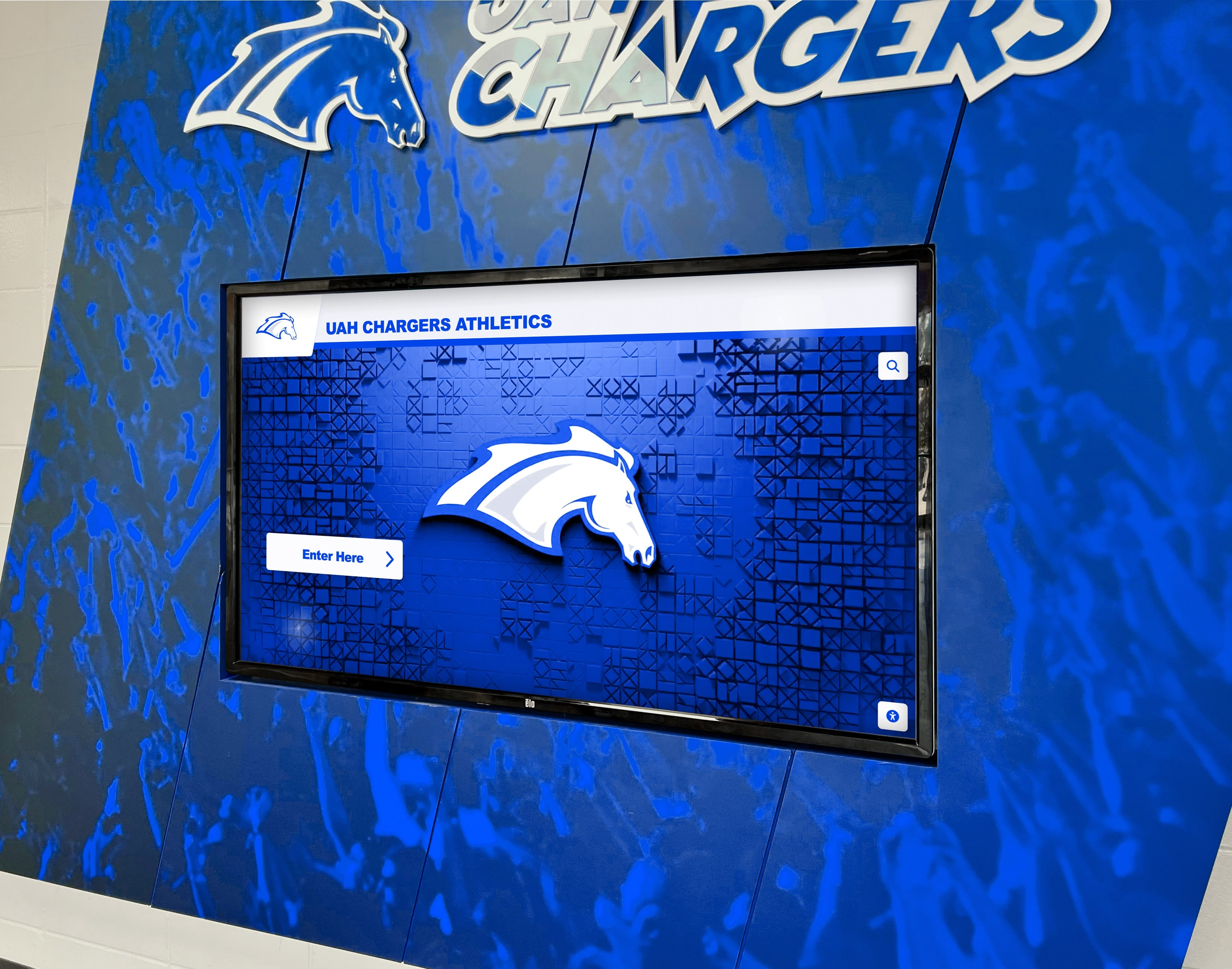
Semi-Professional and Alternative Football Leagues
Various semi-professional leagues, arena football organizations, and alternative professional leagues have operated throughout football history. Some maintain recognition programs celebrating their specific histories and contributors.
These programs serve important purposes documenting football’s full ecosystem beyond the NFL and celebrating players and coaches who contributed to football culture even when circumstances prevented them from reaching the sport’s highest professional levels.
Future Trends in Football Recognition
Recognition technology and approaches continue evolving with emerging capabilities that will enhance football hall of fame programs.
Enhanced Digital Experiences
Expect continued innovation in recognition content formats including virtual reality experiences recreating historic games and moments, augmented reality features overlaying digital content during facility visits, AI-generated content analysis providing new perspectives on historical achievements, and interactive comparison tools enabling visitors to analyze players across different eras using advanced statistics.
These technologies will make historical achievements more accessible and engaging, particularly for younger audiences who expect immersive digital experiences.
Social Integration and Fan Engagement
Future recognition systems will likely feature enhanced social connectivity including fan voting or input on special recognition categories, social media integration enabling content sharing across platforms, community content contribution where fans can share memories and perspectives, and live streaming of induction ceremonies and events integrated with recognition platforms.
This participatory approach transforms recognition programs from institutional top-down initiatives into community-driven celebrations of shared football passion.

Data Analytics and Advanced Statistics
Football analytics continue advancing with new metrics and evaluation frameworks. Recognition systems will increasingly incorporate advanced statistical analysis, comparative tools enabling cross-era player evaluation using standardized metrics, visualization of career arcs and performance patterns, and integration with play-by-play data enabling granular achievement documentation.
These analytical enhancements will provide richer contexts for understanding and appreciating historical achievements while enabling more sophisticated discussions about excellence and legacy.
Conclusion: Preserving Football’s Greatest Legacies
NFL hall of fame programs serve essential purposes within professional football culture—preserving history, celebrating excellence, defining standards, inspiring future generations, and connecting communities through shared appreciation of achievement. From the Pro Football Hall of Fame in Canton to team-specific recognition programs across all 32 franchises, these institutions ensure that extraordinary contributions endure beyond playing careers and championship seasons.
Whether implemented through traditional physical displays in prestigious museums, team facility installations celebrating franchise legends, or modern digital interactive systems serving various organizational contexts, effective recognition programs require thoughtful planning, clear selection criteria, compelling content, appropriate technology, and sustained commitment to ongoing management.
Organizations across football’s ecosystem—from professional teams to college programs to youth organizations—can implement meaningful recognition programs that celebrate achievement, inspire excellence, and strengthen communities. Modern digital recognition technology makes sophisticated recognition programs accessible to organizations of all sizes and budgets, democratizing capabilities once available only to major institutions.

For organizations interested in creating or enhancing football recognition programs, solutions like Rocket Alumni Solutions provide comprehensive platforms specifically designed for sports recognition applications. These specialized systems address unique needs of athletic recognition including position-specific categorization, statistical integration, team roster displays, and multimedia capabilities that bring achievements to life.
Ready to explore how digital recognition technology can transform your organization’s ability to celebrate football excellence? Whether honoring professional legends, celebrating college or high school achievements, or recognizing youth program alumni, modern solutions provide practical approaches for creating engaging recognition programs that serve multiple strategic objectives while preserving football’s greatest legacies for future generations.
